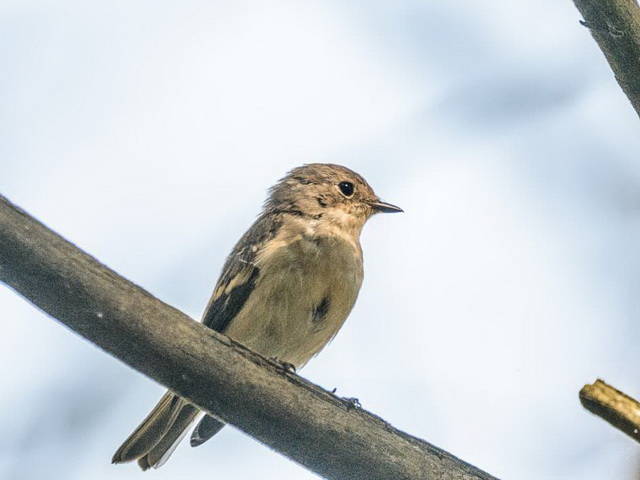
In spring and summer Red-breasted Flycatcher adult male's the upper-head and upper-neck are brownish-grey passed to ashy-grey on forehead, ears coverts, neck-flanks, craw-flanks and breast-flanks. Mantle is brownish-grey, tail is piebald - central tail feather are dark-brown almost black, other ones are white with blackish terminal part. Chin, throat, craw and upper-breast are rufous, other underparts are white. Flanks and underwings are buff. Female is browner than male; without grey tones; rufous color on underparts changed by buffy patches lightened on throat. Juveniles are mottled; upperparts feathers are with buffy centers and dark edges, craw and breast are grayish with dark streaks, belly and undertail are white. On flanks of rear-belly there are two large buffy patches. First-year male is even slightly paler than adult female; without buffy patches on breast and flanks and without rufous throat-patch. In second year craw becomes much rufous; but only in third year craw becomes bright-rufous. Bill is dark-brown with slightly paler base, eyes are walnut color, legs and claws are black-brown. Sizes: wing 64-71, tail 48-57, tarsus 16-18. Weight: 8.4 - 10.6 gr.
Red-breasted Flycatcher breeds in Western and Eastern Kazakhstan; on migration it occurs in far and away wide territory. Please see the detailed distribution in Kazakhstan in the section Subspecies.
Red-breasted Flycatcher is rare breeding migrant. It inhabits flood-land deciduous and mixed forests on plains and in mountains up to 1300 m in Altai. On migration Red-breasted Flycatcher visits bush thickets, man-made forests and groves. It arrives in end of April - early May; poor flight finishes in end of May. Nest is built in tree (in Siberia mostly in tree holes) at 0.1-1.1 m above ground; nest is from moss, dry grass, bast, thin rootlets, and is lined with poplar fluff, hair and feathers. Only female builds nest. Clutches of 4-7 eggs founded in end of May - mid-June. Broods recorded in end June - late July. Only one nest is known for Kazakhstan. Autumn migration passes from the end of August, majority of birds fly out in September, latest migrants recorded in mid - end October.
"Птицы Казахстана" том 3. "Наука". Алма-Ата, 1970. Э.И.Гаврилов. "Фауна и распространение птиц Казахстана". Алматы, 1999. Gavrilov E. I., Gavrilov A. E. "The Birds of Kazakhstan". Almaty, 2005